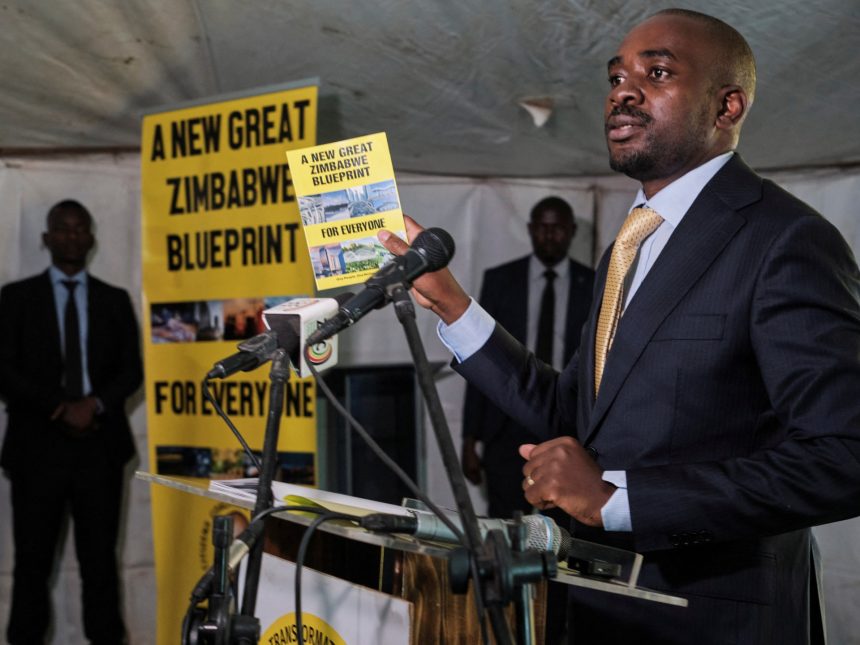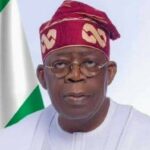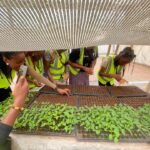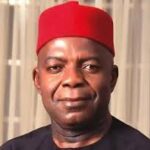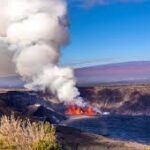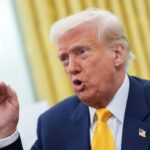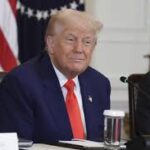[ad_1]
In July 2018, Zimbabwe’s president and leader of its ruling ZANU-PF party, Emmerson Mnangagwa, narrowly won his re-election bid against the Movement for Democratic Change alliance (MDC) leader Nelson Chamisa.
Mnangagwa’s landmark victory, which ensured the continuation of the rule of the Zimbabwe African National Union-Patriotic Front (ZANU-PF) after long-term President Robert Mugabe’s ousting from power, was strongly disputed.
Chamisa alleged that the vote was rigged in favour of the incumbent and launched a legal challenge to nullify it, but Zimbabwe’s Constitutional Court struck it down, saying the opposition leader “failed to prove fraud accusations”.
Five years on, Mnangagwa is now at the end of an objectively disappointing first full term as president, and Chamisa is gearing up to face him at the ballot box once again.
On August 23, Zimbabweans will head to the polls to elect councillors, members of parliament, and a president. Chamisa will attempt to lead his new party, the Citizens Coalition for Change (CCC), to a historic win, oust ZANU-PF from power after 43 years, and become Zimbabwe’s next president.
After years of bitter internal wrangling damaged the MDC beyond repair, Chamisa has been forced to find a new opposition movement, and announced the formation of the CCC in January 2022. But the move did not take away from the grassroots support Chamisa has long been enjoying. Several recent polls suggest that he and the CCC are on course to win the upcoming elections with healthy margins.
A poll of 2,000 registered voters, conducted by Elite Africa Research in June, for example, found that if the elections had been held that month, 47.6 percent of respondents would vote for Chamisa, while just 38.7 percent would vote for President Emmerson Mnangagwa. The same survey also determined that 77.5 percent of voters believe Zimbabwe’s economy is getting worse under Mnangagwa.
All this is hardly surprising as Mnangagwa’s first report card as president is less than impressive.
Five years ago, the ZANU-PF veteran vowed to transform Zimbabwe into a middle-income economy by 2030. “This is a new beginning,” he wrote after winning the election. “Let us join hands, in peace, unity, love and together build a new Zimbabwe for all!”
Regrettably, however, Mnangagwa’s presidency changed very little in Zimbabwe. Sure, his administration refurbished the Robert Gabriel Mugabe International Airport, modernised the Beitbridge Border Post, rehabilitated the Harare-Masvingo-Beitbridge Road, and built a new (Chinese-funded) parliament building. But other than completing these admittedly important and ambitious infrastructure projects, Mnangagwa has achieved very little during his time in power.
He actually failed to deliver on almost all of his key campaign promises. For example, on the campaign trail, he pledged to build 1.5 million houses by 2023, or at least 300 000 units a year throughout his first term in power. But, hardly two years later, his Housing and Social Amenities Minister Daniel Garwe made a U-turn and revised that figure. “The target that we were given by government is 100,000 per year,” he said. “But because of other challenges, if we achieve between 20,000 to 30,000 per year we would have done well.” Since then, Mnangagwa’s “Second Republic” – his chosen name for post-Mugabe Zimbabwe – has struggled to meet even the revised targets and came nowhere near building the much-anticipated 1.5 million houses he initially promised.
Other critical promises made in 2018 have remained unfilled, too. The new government failed to connect all rural areas to the electrical grid, build a new hospital in every district, construct 2,000 new schools and fully revamp the rail and road networks.
Likewise, Mnangagwa’s promises to create new jobs and tackle unemployment remain unfulfilled. According to the most recent labour force survey by the Zimbabwe National Statistics Agency (ZIMSTAT) published in October 2022, only 3.3 million of the 9 million working-age people in the country are employed. Furthermore, 88 percent of those 3.3 million workers are in informal employment and 62 percent of them are earning just $51 per month. Worryingly, the survey also found that 48.7 percent of youth between the ages 15-24 are just “roaming around the streets” and not acquiring a formal education or work-related training.
Desperate to find jobs, others seem to be moving abroad – or at least trying to. Last year, the authorities said they arrested more than 89,000 Zimbabweans who attempted to enter South Africa through unregulated entry points along the Limpopo River. There has also been a marked increase in medical tourism to South Africa as Zimbabwe’s public health sector struggled to provide even the most basic services. Clearly, the last five years have not gone according to Mnangagwa’s plans.
Perhaps as a last-ditch effort to hide the many failure and disappointments that shaped the incumbent president’s first term, ZANU-PF decided not to publish a manifesto for the 2023 elections.
Mnangagwa’s chief election agent, Justice Minister Ziyambi Ziyambi, said rather than coming up with a new manifesto, the ruling party decided to stand “on the record of the Second Republic” and “let its life-changing developmental projects … speak for themselves”.
The CCC, in contrast, put out an ambitious manifesto, the New Great Zimbabwe Blueprint for Everyone, to detail its vision for the country.
In the 100-page document, among many other promises, the party has pledged to restore macroeconomic stability, build a $100bn exporting economy, and create 2.5 million jobs within five years. It has also pledged to provide free primary education from grade one to seven to all Zimbabwean children and provide title deeds to farmers resettled under the government’s land redistribution programme.
Speaking at the launch of the manifesto, Chamisa said the “Zimbabwean crisis is essentially a crisis of governance”.
This simple message resonates well with millions of everyday Zimbabweans who are suffering the grave consequences of chronic economic mismanagement, cronyism, and corruption in Mnangagwa’s Zimbabwe.
Just a few months ago in April, Zimbabweans watched in absolute disbelief as the Gold Mafia, a four-part investigation by Al Jazeera, placed Mnangagwa at the epicentre of a complex gold smuggling scheme.
For those sick and tired of Mnangagwa’s unscrupulous leadership and countless political shenanigans, Chamisa’s uncomplicated message, honest ambition and commitment to achieve meaningful change are a breath of fresh air. Everyone who wants to see Zimbabwe turn a page on corrupt elite politics is now rooting for Chamisa and his CCC party.
Chemisa grew up in Kuwadzana, a sprawling high-density township in Harare where the widespread effects of ZANU-PF’s socioeconomic failures – especially unemployment, hunger and poverty – are experienced particularly severely. In 2003, at the age of 25, he became the youngest-ever member of Zimbabwe’s parliament, but his early entry into electoral politics did not alienate him from the people. Two decades and several elections later, he is still very much considered a man of the people.
Chamisa also has first-hand experience of ZANU-PF’s treatment of those who dare to dissent from its rule – and thus is well-placed to lead the country’s move away from the party that dominated it since independence.
Indeed, in March 2007, he was ambushed and beaten to a pulp by eight unidentified men wielding iron bars in the departure lounge of the then Harare International Airport, before he could board a plane to Brussels.
A week earlier, the police had arrested him and other opposition officials in Highfield on spurious charges and beaten them with truncheons, metal bars, rifle butts and a “sjambok” (a short whip).
On both occasions, Chamisa was severely wounded and had to be hospitalised.
After fighting ZANU-PF oppression and overreach for so long, the young leader has evolved into the quintessential post-colonial Zimbabwean citizen and become a symbol of the people’s undying desire for political change.
Mnangagwa – a cold, inexpressive and wealthy career politician, who played an instrumental role in the Gukurahundi massacres in Matabeleland in the 1980s – has long been the exact opposite.
In August 2018 and January 2019, he ordered crackdowns on protests that left scores of unarmed civilians dead and injured. Supporters of his government abducted and sexually assaulted three opposition officials, including a member of parliament, in May 2020.
And the violence continues to this day. Earlier this month, ZANU-PF members stoned a CCC activist, Tinashe Chitsunge, to death.
Writing in the New York Times in March 2018, in a piece titled “We are bringing about the New Zimbabwe”, Mnangagwa claimed that “All citizens will have the right of free speech, free expression and free association” under his rule.
He clearly lied to the world.
In the same piece, he also claimed that Zimbabwe is changing – politically, economically and societally – under his leadership, and called on Western nations to “reconsider” the sanctions they have long been imposing on Zimbabwean entities and individuals for impeding democracy and enabling corruption.
“We are bringing about the new Zimbabwe – a country of hope and opportunity, a country that engages with the world and strives toward prosperity,” he wrote, as he promised to do what is necessary to end his country’s isolation.
But he seems to have lied about that, too.
In the end, Mnangagwa failed to implement any meaningful reforms that could have led to the removal of Western sanctions. Instead, his administration has cemented economic and diplomatic ties with other global pariahs, namely Russia and Belarus.
In 2018, Mnangagwa was presented with an opportunity to lead Zimbabwe into a new era. He failed. Chamisa should now be given a chance to try and build a “Great new Zimbabwe for everyone”. Unlike his rival, after all, the opposition leader has never been caught in a lie, and has a real chance of delivering a better future for his long-suffering compatriots.
The views expressed in this article are the author’s own and do not necessarily reflect Al Jazeera’s editorial stance.
[ad_2]
Source link
